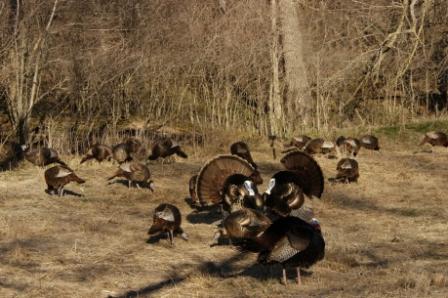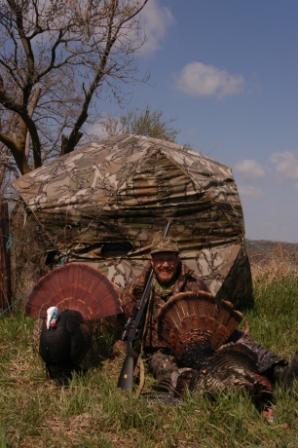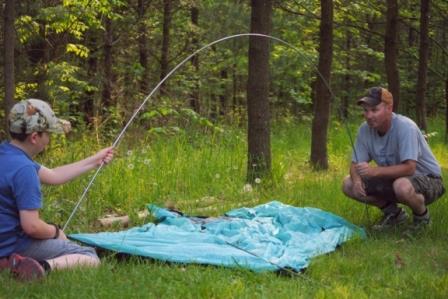By Judd Cooney
Patience Pays For Persnickety Toms
 “C’mon, let’s go after those gobblers across the creek,” coaxed my cohort. “Or maybe we ought to try the gobbler back over the ridge, or even the gobblers tearing it up down the creek bottom a quarter mile below us,” implored my totally antsy and frustrated turkey hunting client, as we listened to gobblers sounding off all round us, just as the sun was gilding the tree tops on the ridge above with its golden light.
“C’mon, let’s go after those gobblers across the creek,” coaxed my cohort. “Or maybe we ought to try the gobbler back over the ridge, or even the gobblers tearing it up down the creek bottom a quarter mile below us,” implored my totally antsy and frustrated turkey hunting client, as we listened to gobblers sounding off all round us, just as the sun was gilding the tree tops on the ridge above with its golden light.
“Just shut up and be patient.” I admonished my client. “There’re too many turkeys in the woods for us to try to sneak anywhere. All we’ll do is spook birds. Besides the object of calling turkeys is to let them come to you, so sit back and be patient.”
We’d gotten into position on the edge of a small clover plot at the bottom of a wooded slope, adjacent to a dirt dam that backed up the creek for a quarter mile above us. My client and I were comfortably ensconced on the shadowed side of a large maple tree, with a clear view of the open plot and wooded slope above.
I explained to my client on the drive to the hunting area, that regardless of how many gobblers we heard, we were going to stay put and let a gullible gobbler come to us rather than try to sneak within calling range of a  roosted bird. I learned a long time ago that when dealing with lots of turkeys in an area, and especially areas where there are a lot more hens than gobblers, it’s often more effective to find a good calling location and set up to call, than trying to set up on a specific gobbling tom.
roosted bird. I learned a long time ago that when dealing with lots of turkeys in an area, and especially areas where there are a lot more hens than gobblers, it’s often more effective to find a good calling location and set up to call, than trying to set up on a specific gobbling tom.
I informed my client that we would hear lots of gobbling, and I would call every twenty minutes until I got a gobbler or two to actually respond to my calling, but it may be mid-morning before this happened. After almost two hours of being serenaded by the vocal gobblers surrounding us, and watching several longbeards pay court to their harem of hens on the distant hillsides (my client counted over 265 gobblers!), I finally got a response. A pair of gobblers on the timbered ridge above responded enthusiastically to my yelps, and when I started cutting excitedly, they left little doubt about their interest, gobbling and double gobbling enthusiastically as they closed the distance.
 Ten minutes of yelping, clucking, cutting and finally soft purring brought both gobblers out of the woods and into the clover patch at 30 yards, where my hyperventilating client made a clean kill on the largest tom which sported a heavy 11″ beard and 1 3/4″ spurs.
Ten minutes of yelping, clucking, cutting and finally soft purring brought both gobblers out of the woods and into the clover patch at 30 yards, where my hyperventilating client made a clean kill on the largest tom which sported a heavy 11″ beard and 1 3/4″ spurs.
I have done my share of “run and gun,” turkey hunting over the years, but the more I hunt these irascible and unpredictable birds, the less inclined I am to chase after them unless there is simply no other way. Since I started actively guiding and outfitting for spring turkey hunters in Iowa, Missouri and Nebraska almost twenty years ago, I have found that my clients and I are far more successful when we use patience and perseverance in our turkey hunting. The more turkeys you have in your hunting area the better this tactic works.
One of the biggest obstacles to conning longbeards anywhere, regardless of the subspecies hunted, is HENS. The higher the hen-per-gobbler ratio the tougher the toms are to call. A henned up tom is a firm believer in the old axiom, “A bird in the hand is worth two in the bush.” A gobbler’s brain is the size of a pea, but even pea-brained gobblers are hesitant to leave a harem and venture several hundred yards through the woods or across an open meadow, to check out the sounds of another hen he can’t see.
 However, the longer the gobbler hears the seductive sounds of a hen the more his curiosity is aroused. You can bet he will remember EXACTLY the location of that vociferous and seductive sounding hen, and IF and WHEN his hens wander off or scatter out ignoring him, he’s more than likely to check out the location where he last heard the hen or even more likely to check out the persistent hen if she’s still calling. This may be a few minutes or a few hours, but the chances of a gobbler checking out your calling increases as time goes by, rather than decreases as most callers think.
However, the longer the gobbler hears the seductive sounds of a hen the more his curiosity is aroused. You can bet he will remember EXACTLY the location of that vociferous and seductive sounding hen, and IF and WHEN his hens wander off or scatter out ignoring him, he’s more than likely to check out the location where he last heard the hen or even more likely to check out the persistent hen if she’s still calling. This may be a few minutes or a few hours, but the chances of a gobbler checking out your calling increases as time goes by, rather than decreases as most callers think.
One of my turkey hunting buddies from a southern state, hunted Iowa with me for several successive springs after I had spent several years chasing Mississippi and Alabama gobblers with him. We covered lots of country down south chasing after gobblers. But when he came to Iowa, he used the same tactics with far less success, even though we had many times the turkey concentrations on our private leases.
After the second year’s season was over he humbly admitted that he felt he had only managed to call in a couple of Iowa gobblers. In fact, most of the time the gobblers ignored his best calling efforts, and sometimes even headed the other direction. I’d always chided him that his southern drawl could not be comprehended by the “Iowegian” birds. He was an excellent turkey caller. I told him though, that he had without doubt called in lots of gobblers during his hunts, but that he was never at the calling location when the tom’s got there.
 On his last turkey hunt he was guiding a major call manufacturer who was shooting a turkey hunting video segment. After spending an unsuccessful morning “running and gunning”, they had several turkey encounters, but no gobblers called up for video. At mid afternoon I told him exactly where to go and set up, with specific instructions to stay put regardless of how many gobblers he heard on the lease. He was to call every twenty minutes or so until he got a gobbler to come in or it got dark. But under no circumstances was he or his hunter to go chasing after any vocal toms. Two hours after setting out decoys and dozing off several times between calling spurts, a gobbler responded and strutted across the open field in front of them and around the decoy, providing the best video this company had gotten all spring.
On his last turkey hunt he was guiding a major call manufacturer who was shooting a turkey hunting video segment. After spending an unsuccessful morning “running and gunning”, they had several turkey encounters, but no gobblers called up for video. At mid afternoon I told him exactly where to go and set up, with specific instructions to stay put regardless of how many gobblers he heard on the lease. He was to call every twenty minutes or so until he got a gobbler to come in or it got dark. But under no circumstances was he or his hunter to go chasing after any vocal toms. Two hours after setting out decoys and dozing off several times between calling spurts, a gobbler responded and strutted across the open field in front of them and around the decoy, providing the best video this company had gotten all spring.
Patience was the key to their success.
On Midwestern turkey hunts I’ve called up and killed more gobblers between 10:00 AM and 2:00 PM than during any other time frame. Throughout the early morning and as they leave the roost, almost every gobbler in our hunting area will have hens in sight or have hens around them. This makes them difficult to call right off the roost, or later as they spend the morning feeding and loafing. With high hen to gobbler ratios, the hens are far more aggressive and will jealously pull any gobblers around them, away from anything that sounds like a competing feathered female. This is a major problem on our Iowa hunting leases from the seasons opening day, to the final day’s sunset.
 By mid morning the birds are scattering out and the hens are wandering off looking for nest sites, or nesting until later in the afternoon when they rejoin the toms for the evening roost. Typical with males of any species, some gobblers are simply going to lose interest in their present companions and look for new conquests. The seductive or excited hen calling they’ve been hearing from you all morning, or before the flock moved out of hearing has piqued their interest, and you can bet-your-bippy those longbeards will have pinpointed your location to within a few yards.
By mid morning the birds are scattering out and the hens are wandering off looking for nest sites, or nesting until later in the afternoon when they rejoin the toms for the evening roost. Typical with males of any species, some gobblers are simply going to lose interest in their present companions and look for new conquests. The seductive or excited hen calling they’ve been hearing from you all morning, or before the flock moved out of hearing has piqued their interest, and you can bet-your-bippy those longbeards will have pinpointed your location to within a few yards.
When I set up to call, I make sure I get comfortable enough to remain for a long period without moving. I often use varying decoy set-ups depending on the time of season, from a lone hen, to several jakes and a couple hens, to a strutting tom and lone hen. I get out three calls; a Quaker Boy Jagged Edge diaphragm call for general yelping, cutting and clucking; a loud super sounding Paul’s Calls box call for distant reaching yelps and cuts; and a sweet sounding slate call for close-up purring and clucking to bring a gobbler in that last few yards.
 I usually call every twenty minutes keeping track on my watch, as judging time in a calling situation can be difficult at best, and over calling will spook more gobblers than under calling. Once I get a gobbler in sight or know he’s coming, I let his actions and vocalizations set the tempo of my calling responses, and I generally call less than the gobbler.
I usually call every twenty minutes keeping track on my watch, as judging time in a calling situation can be difficult at best, and over calling will spook more gobblers than under calling. Once I get a gobbler in sight or know he’s coming, I let his actions and vocalizations set the tempo of my calling responses, and I generally call less than the gobbler.
On a number of occasions I’ve been calling for an hour or more, and finally have gotten a gobbler or two to respond enthusiastically to my calling, only to have a silent gobbler suddenly appear out of nowhere trying to steal the hen from its vocal competition.
Spring turkey calling is an endeavor in conning a gullible gobbler to come within shooting range. Your deadliest and most effective assets may not be your calling expertise or chosen hunting gear, but simply PATIENCE and PERSEVERANCE. So sit back, get comfortable and let it happen!
 For the past 30 years Judd Cooney has been writing and photographing full time in addition to running his guiding and outfitting operation, spending 18-20 hours a day trying to avoid working an 8-5 job. He says, “I wouldn’t change it for the world!” He has articles or photos in many of the outdoor magazines every month, covering bowhunting, muzzleloader hunting, big game, small game and predator hunting, plus turkey, waterfowl and upland game hunting. He can be reached through his website,www.JuddCooney.com.
For the past 30 years Judd Cooney has been writing and photographing full time in addition to running his guiding and outfitting operation, spending 18-20 hours a day trying to avoid working an 8-5 job. He says, “I wouldn’t change it for the world!” He has articles or photos in many of the outdoor magazines every month, covering bowhunting, muzzleloader hunting, big game, small game and predator hunting, plus turkey, waterfowl and upland game hunting. He can be reached through his website,www.JuddCooney.com.
Download your Free eBook, now!
8,569 total views, no views today





 What to Do for Water?
What to Do for Water?
















 Steve Sorensen is the author of
Steve Sorensen is the author of 